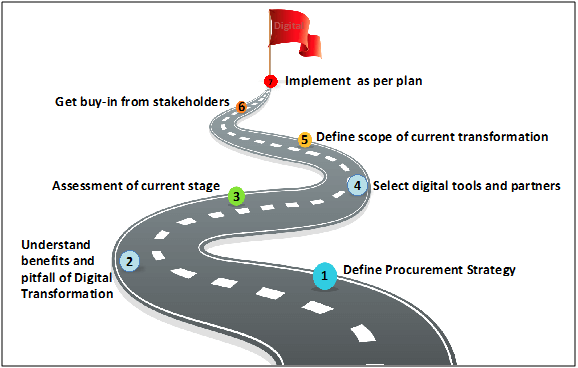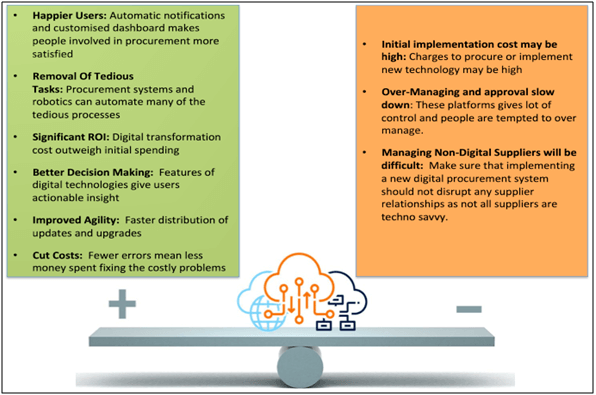Procurement is a purchasing process that controls quantity, quality, sourcing and timing to ensure the best possible total cost of ownership. Procurement professionals are nowadays key member of firm’s core team and are actively participating in new product development, managing supplier risk and sustainable procurement. Digital technologies are enablers and supporting procurement in this direction. Procurement leads needs to define a clear strategic roadmap to achieve digital procurement.

As you can see from above diagram, a strategic roadmap covers the following steps:
1. Define Procurement Strategy
2. Understand benefits and pitfalls of Digital Procurement
3. Assessment of current stage
4. Select digital tools and partners
5. Define scope of current transformation
6. Get buy-in from stakeholders
7. Implement as per plan
Table of Contents
Defining Procurement Strategy
Strategy should clearly articulate the goal of the organisation. It should improve effectiveness, efficiency and sustainability. From the effectiveness perspective, the goal is to reduce price, or total cost of ownership (TCO) and up the revenue. Sustainability means reducing supplier risk, continuously innovate and show agile way of working.
Beside effectiveness and sustainability, it’s important to improve efficiency. Efficiency means that you have insights or actionable intelligence, work you do should enhance customer, supplier and workforce experience and encourage collaboration. The future of Digital Procurement will enhance all three areas of Procurement, as shown in the diagram below. Strategic Sourcing will become more predictive, and transactional sourcing will become more automated, with supplier relationship management becoming more proactive.

Understanding Digital Transformation
It is always better to understand deeply the benefits and pitfalls of digital transformation, and is easier to sell ideas of transformation to senior management and users once you have thorough knowledge on this area.
Below is a diagram that depicts the key benefits and pitfalls of digital implementation.

Assessing Current Stage and Digital Tools Selection
People, Process and Technology are three core elements for successful business transformation A balanced focus is needed to address each one of them. Ignoring any one of them means that you cannot create true value of transformation.
Digital tools impact the four key areas of automation, decision-making, connectivity, and innovation. Thus it is always better to select tools according to the procurement strategy or objectives.

Defining Scope of Current Transformation
The following questions address the scope of transformation.
• Clearly define what is covered and
• How much time it will take to achieve the defined scope
• Assess the cost of procurement transformation
• Build the business case so that you can get senior management approval.
The scope should clearly answer following questions
• What will you do as part of procurement transformation?
• What will you not do as part of procurement transformation?
Getting Buy-in from Stakeholders
Sponsorship is critical for procurement transformation and he or she should be Senior most in the organisation. Depending upon the scope, procurement transformation could be expensive. So spend some time calculating the return in the form of Internal rate of Return and Net Present value of your proposed investment. Procurement success is based on stakeholder engagement. The better the engagement, the better the chance for success. So, take views of all control functions you generally work with e.g., legal, compliance and data protection. It is always better to take views from client who you are supporting. Your client may have concern on supply chain or concerns around how the vendors would react to it.
Whatever the concerns might be, list them down, discuss the concerns and make sure you and your stakeholders agree on the game plan. Finally, always take views from your own procurement team. Create a team of change agents whose responsibility is to take continuous feedback from team members.
The full content is only visible to SIPMM members
Already a member? Please Login to continue reading.
References
Giles Breault. The Startup (2018). “Procurement Agility in the Age of Digitalisation”. Retrieved from https://medium.com/swlh/procurement-agility-in-the-age-of-digitalisation-e5b9a71da9dd, accessed 15 Dec 2019.
Hunter Lowe. (2019). “What is digital procurement”. Retrieved from https://selecthub.com/eprocurement/what-is-digital-procurement, accessed 15 Dec 2019.
Joe Kok Kong Loong, DPSM (2019) “Essential technology application for public procurement. Retrieved from SIPMM: https://publication.sipmm.edu.sg/essential-technology-application-public-procurement/, accessed 15 Dec 2019.
McKinsey & Company. (2019). “Roadmap for a digital transformation”. Retrieved from https://www.mckinsey.com/industries/financial-services/our-insights/a-roadmap-for-a-digital-transformation, accessed15 Dec 2019.
Paisley Ang Siew Boay, DPSM (2019) “Key consideration for sustainable procurement”. Retrieved from SIPMM: https://publication.sipmm.edu.sg/key-considerations-sustainable-procurement-2/, accessed 15 Dec 2019.
Philips Charles Loges, ADPSM (2019) “Crucial Digital Technologies for Effective Procurement”. Retrieved from SIPMM: https://publication.sipmm.edu.sg/crucial-digital-technologies-effective-procurement/, accessed 15 Dec 2019.
ProcureDesk. (2019) “Procurement Transformation Roadmap [7 Steps to transformation]”. Available at: https://www.procuredesk.com/procurement-transformation/, accessed 14 Dec 2019.

